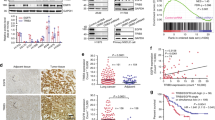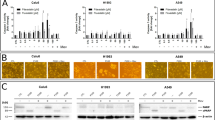Abstract
We recently showed the ability of lovastatin to inhibit the function of the epidermal growth factor receptor (EGFR) and its downstream signaling of the phosphatidylinositol-3 kinase/AKT pathway. Combining lovastatin with gefitinib, a potent EGFR inhibitor, induced synergistic cytotoxicity in various tumor-derived cell lines. In this study, lovastatin treatment was found to inhibit ligand-induced EGFR dimerization in squamous cell carcinoma cells and its activation of AKT and its downstream targets 4E-binding protein 1 and S6 kinase 1. This inhibition was associated with global protein translational inhibition shown by a decrease in RNA associated polysome fractions. The effects of lovastatin on EGFR function were reversed by the addition of geranylgeranyl pyrophosphate, which functions as a protein membrane anchor. Lovastatin treatment induced actin cytoskeletal disorganization and the expression of geranylgeranylated rho family proteins that regulate the actin cytoskeleton, including rhoA. Lovastatin-induced rhoA was inactive as EGF stimulation failed to activate rhoA and inhibition of the rho-associated kinase, a target and mediator of rhoA function, with Y-27632 also showed inhibitory effects on EGFR dimerization. The ability of lovastatin to inhibit EGFR dimerization is a novel exploitable mechanism regulating this therapeutically relevant target. To explore the potential clinical significance of this combination, we evaluated the effect of statin on the overall survival (OS) and disease-specific survival (DSS) of patients with advanced non-small-cell lung cancer enrolled in the NCIC Clinical Trials Group phase III clinical trials BR21 (EGFR tyrosine kinase inhibitor erlotinib versus placebo) and BR18 (carboplatin and paclitaxel with or without the metalloproteinase inhibitor BMS275291). In BR18, use of statin did not affect OS or DSS. In BR21, patients showed a trend for improvement in OS (HR: 0.69, P=0.098) and DSS (HR: 0.62, P=0.048), but there was no statin × treatment interaction effect (P=0.34 and P=0.51 for OS and DSS, respectively).
This is a preview of subscription content, access via your institution
Access options
Subscribe to this journal
Receive 50 print issues and online access
$259.00 per year
only $5.18 per issue
Buy this article
- Purchase on Springer Link
- Instant access to full article PDF
Prices may be subject to local taxes which are calculated during checkout







Similar content being viewed by others
Abbreviations
- DSS:
-
disease specific survival
- EGFR:
-
epidermal growth factor receptor
- FPP:
-
farnesyl pyrophosphate
- GGPP:
-
geranylgeranyl pyrophosphate
- NSCLC:
-
non-small-cell lung carcinoma
- OS:
-
overall survival
- ROCK:
-
rho-associated kinase
- SCC:
-
squamous cell carcinoma
References
Amano M, Fukata Y, Kaibuchi K . (2000). Regulation and functions of Rho-associated kinase. Exp Cell Res 261: 44–51.
Blais JD, Filipenko V, Bi M, Harding HP, Ron D, Koumenis C et al. (2004). Activating transcription factor 4 is translationally regulated by hypoxic stress. Mol Cell Biol 24: 7469–7482.
Boulougouris P, Elder J . (2001). Epidermal growth factor receptor structure, regulation, mitogenic signalling and effects of activation. Anticancer Res 21: 2769–2775.
Breathnach OS, Freidlin B, Conley B, Green MR, Johnson DH, Gandara DR et al. (2001). Twenty-two years of phase III trials for patients with advanced non-small-cell lung cancer: sobering results. J Clin Oncol 19: 1734–1742.
Cabebe E, Wakelee H . (2007). Role of anti-angiogenesis agents in treating NSCLC: focus on bevacizumab and VEGFR tyrosine kinase inhibitors. Curr Treat Options Oncol 8: 15–27.
Cicha I, Schneiderhan-Marra N, Yilmaz A, Garlichs CD, Goppelt-Struebe M . (2004). Monitoring the cellular effects of HMG-CoA reductase inhibitors in vitro and ex vivo. Arterioscler Thromb Vasc Biol 24: 2046–2050.
Corsini A, Maggi FM, Catapano AL . (1995). Pharmacology of competitive inhibitors of HMG-CoA reductase. Pharmacol Res 31: 9–27.
Dann SG, Thomas G . (2006). The amino acid sensitive TOR pathway from yeast to mammals. FEBS Lett 580: 2821–2829.
Darenfed H, Dayanandan B, Zhang T, Hsieh SH, Fournier AE, Mandato CA . (2006). Molecular characterization of the effects of Y-27632. Cell Motil Cytoskeleton. 64: 97–109.
Dimitroulakos J, Lorimer IA, Goss G . (2006). Strategies to enhance epidermal growth factor inhibition: targeting the mevalonate pathway. Clin Cancer Res 12(14 Part 2): 4426s–4431s.
Dimitroulakos J, Marhin WH, Tokunaga J, Irish J, Gullane P, Penn LZ et al. (2002). Microarray and biochemical analysis of lovastatin-induced apoptosis of squamous cell carcinomas. Neoplasia 4: 337–346.
Doherty L, Gigas DC, Kesari S, Drappatz J, Kim R, Zimmerman J et al. (2006). Pilot study of the combination of EGFR and mTOR inhibitors in recurrent malignant gliomas. Neurology 67: 156–158.
Gibbs JB, Oliff A, Kohl NE . (1994). Farnesyltransferase inhibitors: Ras research yields a potential cancer therapeutic. Cell 77: 175–178.
Goldstein JL, Brown MS . (1990). Regulation of the mevalonate pathway. Nature 343: 425–430.
Greenlee RT, Murray T, Bolden S, Wingo PA . (2000). Cancer statistics, 2000. CA Cancer J Clin 50: 7–33.
Hall A . (2005). Rho GTPases and the control of cell behaviour. Biochem Soc Trans 33: 891–895.
Herbst RS . (2002). ZD1839: targeting the epidermal growth factor receptor in cancer therapy. Expert Opin Investig Drugs 11: 837–849.
Herbst RS . (2003). Erlotinib (Tarceva): an update on the clinical trial program. Semin Oncol 30: 34–46.
Leighl NB, Paz-Ares L, Douillard JY, Peschel C, Arnold A, Depierre A et al. (2005). Randomized phase III study of matrix metalloproteinase inhibitor BMS-275291 in combination with paclitaxel and carboplatin in advanced non-small-cell lung cancer: National Cancer Institute of Canada-Clinical Trials Group Study BR.18. Clin Oncol 23: 2831–2839.
Lunn JA, Wong H, Rozengurt E, Walsh JH . (2000). Requirement of cortical actin organization for bombesin, endothelin, and EGF receptor internalization. Am J Physiol Cell Physiol 279: C2019–C2027.
Mantha AJ, Hanson JE, Goss G, Lagarde AE, Lorimer IA, Dimitroulakos J . (2005). Targeting the mevalonate pathway inhibits the function of the epidermal growth factor receptor. Clin Cancer Res 11: 2398–2407.
Mendelsohn J, Baselga J . (2000). The EGF receptor family as targets for cancer therapy. Oncogene 19: 6550–6565.
Nicholson RI, Gee JM, Harper ME . (2001). EGFR and cancer prognosis. Eur J Cancer 37 (Suppl 4): S9–S15.
Niknejad N, Morley M, Dimitroulakos J . (2007). Activation of the integrated stress response regulates lovastatin-induced apoptosis. J Biol Chem 282: 29748–29756.
Oksvold MP, Skarpen E, Wierod L, Paulsen RE, Huitfeldt HS . (2001). Re-localization of activated EGF receptor and its signal transducers to multivesicular compartments downstream of early endosomes in response to EGF. Eur J Cell Biol 80: 285–294.
Ostman A, Bohmer FD . (2001). Regulation of receptor tyrosine kinase signaling by protein tyrosine phosphatases. Trends Cell Biol 11: 258–266.
Pallet N, Beaune P, Thervet E, Legendre C, Anglicheau D . (2006). [mTOR inhibitors: pleiotropic antiproliferative drugs]. Med Sci (Paris) 22: 947–952.
Pruitt K, Der CJ . (2001). Ras and Rho regulation of the cell cycle and oncogenesis. Cancer Lett 171: 1–10.
Sako Y, Minoghchi S, Yanagida T . (2000). Single-molecule imaging of EGFR signalling on the surface of living cells. Nat Cell Biol 2: 168–172.
Seabra MC, Mules EH, Hume AN . (2002). Rab GTPases, intracellular traffic and disease. Trends Mol Med 8: 23–30.
Sebti S, Hamilton AD . (1997). Inhibitors of prenyl transferases. Curr Opin Oncol 9: 557–561.
Shepherd FA, Rodrigues Pereira J, Ciuleanu T, Tan EH, Hirsh V, Thongprasert S et al. (2005). Erlotinib in previously treated non-small-cell lung cancer. N Engl J Med 353: 123–132.
Sorkin A, Carpenter G . (1991). Dimerization of internalized epidermal growth factor receptors. J Biol Chem 266: 23453–23460.
Sorokin A, Lemmon MA, Ullrich A, Schlessinger J . (1994). Stabilization of an active dimeric form of the epidermal growth factor receptor by introduction of an inter-receptor disulfide bond. J Biol Chem 269: 9752–9759.
Thibault A, Samid D, Tompkins AC, Figg WD, Cooper MR, Hohl RJ et al. (1996). Phase 1 study of lovastatin, an inhibitor of the mevalonate pathway, in patients with cancer. Clinical Cancer Res 2: 483–491.
Thomas AL, Morgan B, Drevs J, Unger C, Wiedenmann B, Vanhoefer U et al. (2003). Vascular endothelial growth factor receptor tyrosine kinase inhibitors: PTK787/ZK 222584. Semin Oncol 30: 32–38.
Acknowledgements
Research support from the Canadian Institute of Health Research (JD) and the Ontario Institute for Cancer Research (JD) is greatly appreciated. We thank Dr D. Gray, Apotex Canada and AstraZeneca UK for generously providing the reagents used in this study.
Author information
Authors and Affiliations
Corresponding author
Ethics declarations
Competing interests
The authors declare no conflict of interest.
Rights and permissions
About this article
Cite this article
Zhao, T., Le Francois, B., Goss, G. et al. Lovastatin inhibits EGFR dimerization and AKT activation in squamous cell carcinoma cells: potential regulation by targeting rho proteins. Oncogene 29, 4682–4692 (2010). https://doi.org/10.1038/onc.2010.219
Received:
Revised:
Accepted:
Published:
Issue Date:
DOI: https://doi.org/10.1038/onc.2010.219
Keywords
This article is cited by
-
Anti-cancer effect of doxorubicin is mediated by downregulation of HMG-Co A reductase via inhibition of EGFR/Src pathway
Laboratory Investigation (2019)
-
A phase I study of high-dose rosuvastatin with standard dose erlotinib in patients with advanced solid malignancies
Journal of Translational Medicine (2016)
-
Protein prenylation: unique fats make their mark on biology
Nature Reviews Molecular Cell Biology (2016)
-
Structural insights of a hormone sensitive lipase homologue Est22
Scientific Reports (2016)
-
The role of RhoA in vulvar squamous cell carcinoma: a carcinogenesis, progression, and target therapy marker
Tumor Biology (2016)



